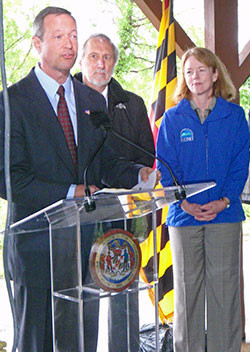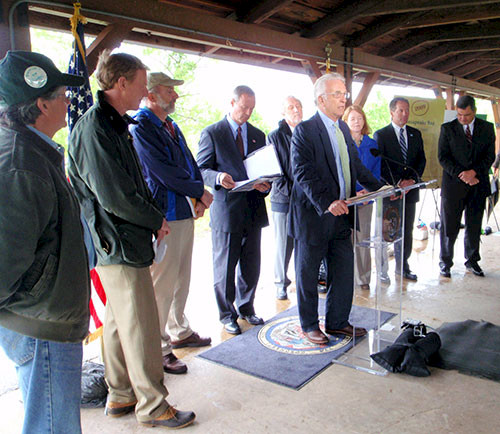Chesapeake Bay report card release
Bill Dennison · 
The 2009 Chesapeake Bay report card release was held at Gunpowder Falls State Park in Baltimore City on May 18. It was a cold rainy day, and the intrepid folks who braved the weather huddled under a pavilion waiting for Maryland Governor Martin O'Malley. This is the first time that the Chesapeake Bay report card produced by the EcoCheck team, a partnership program between NOAA and the University of Maryland Center for Environmental Science (UMCES), was released with elected officials. The late Jody Powell, President Carter's Press Secretary, was on the UMCES Board of Visitors and told us that we should deliver the report card to the highest form of government possible. Jody said that while the scientists provided the rigor to give credibility to the report card, the elected officials provided the public profile to maximize its impact. Thus, when the Governor expressed an interest in the report card release, we readily agreed.

When Governor O'Malley walked up to the podium, he alertly spotted a great blue heron soaring over the water behind us. He quipped that we had organized a 'fly over' for the event. After being introduced by the master of ceremonies for the release, Department of Natural Resources Secretary John Griffin, the Governor launched a new website called Stream Health. This new website provides data on stream fish, benthic macroinvertebrates, and habitat collected by the Maryland Biological Stream Survey (MBSS) and various volunteers known as Stream Waders. The Governor was so enamored by the capabilities of this new web site that he personally called several reporters over to the poster that illustrated various features of this website.
The 2009 report card featured a Bay-wide improvement in scores, going from a C- in 2008 to a C in 2009. Unique precipitation patterns provided us with insights into the relative roles of the Susquehanna River vs. other tributaries to Chesapeake Bay health. Precipitation and the resulting runoff deliver the nutrients, sediments and toxicants from the watershed into the Bay. The Susquehanna River provides roughly half of the freshwater runoff entering Chesapeake Bay, with runoff from New York and Pennsylvania. The average to lower than average precipitation in the Susquehanna watershed contrasted with the extremely wet weather in the Chesapeake tributaries in Maryland and Virginia. The result of these precipitation patterns was an improvement in the mainstem Bay health, particularly the Mid Bay section, which improved from a D+ in 2008 to a C in 2009. The mainstem responded primarily to the Susquehanna River average to low flows. The Maryland and Virginia tributaries also improved somewhat, with the exception of the James River and Upper Western Shores tributaries (Bush and Gunpowder Rivers), which corresponded to regions that experienced record precipitation.

This year's report card release included a novel correlation that resulted from the expanded network of stream health stations, based on the benthic macroinvertebrates (a term that the Governor enjoyed, with the accompanying short version; 'bugs'). A correlation between the stream health index and the Bay health index was performed for watersheds and their adjacent tributaries. A significant positive correlation was determined, providing empirical evidence that healthy streams are needed for a healthy Chesapeake Bay. The scientists, methods and calculations for stream health and Bay health were completely independent also adding validity to the correlation. While this makes intuitive sense, it is the first time that Chesapeake watershed data has been linked to Bay health data.
Following the report card release, we presented the Governor with a copy of "Integrating and Applying Science: A handbook for effective coastal ecosystem assessment", produced by IAN Press. We featured the Governor's BayStat initiative as a novel way of incorporating scientific data into the decision making process. In addition, following the release, the EcoCheck team has begun a tradition of having a margarita with lunch to celebrate the end of a long arduous process culminating in the release.

About the author
Bill Dennison

Dr. Bill Dennison is a Professor of Marine Science and Vice President for Science Application at the University of Maryland Center for Environmental Science.

